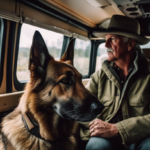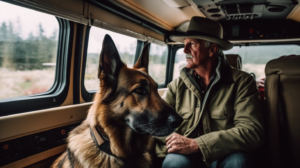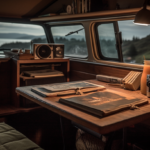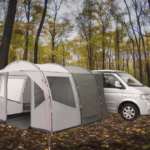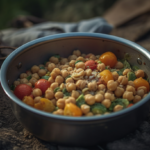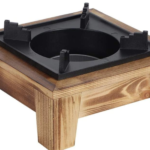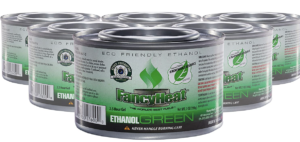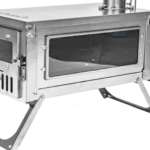
Home
Embracing the Open Road: A Comprehensive Guide to RV Living with Pets
Welcome, fellow travelers and pet lovers! As an RV enthusiast and pet owner, I understand the excitement and challenges of hitting the open road with our furry friends. They’re our companions, our family, and the thought of leaving them behind can be heart-wrenching. So why not bring them along on our adventures?
Why Travel with Your Pet in an RV?
There are numerous benefits of RV travel with pets. On the emotional front, pets provide companionship, comfort, and joy, which can significantly enhance your traveling experience. The shared adventures also strengthen the bond between you and your pet.
For pets, the health benefits can be substantial. The physical activity from exploring new surroundings, coupled with quality time spent with you, can contribute to their overall wellbeing. Pets, like us, thrive on new experiences!
Choosing the Right RV for Your Pet
Just like how every pet is unique, every RV is different. When choosing a pet-friendly RV, the size, layout, and safety features are important factors to consider. Large dogs might need more space, whereas cats might appreciate more vertical space for climbing and perching.
Making your RV comfortable for pets involves small modifications, like adding pet beds in cozy corners or installing a cat tree. Remember, your RV is their home too, so consider their comfort and safety when designing the layout.
Pet-Proofing Your RV
Pet-proofing is crucial when it comes to RV living with pets. This involves securing cabinets, covering sharp edges, and ensuring your pet can’t accidentally escape. It’s also important to think about safe storage of pet food and toys. Be creative with storage solutions to avoid clutter while keeping your pet’s necessities accessible.
Essential Pet Travel Accessories
When you’re traveling with pets in an RV, certain accessories become indispensable. Collapsible bowls, pet seat belts, and portable litter boxes are just a few essentials. A pet first aid kit is also a must. Do your research and choose quality pet travel accessories that offer durability and comfort.
Pet Health and Safety During RV Travels
Taking care of your pet’s health while on the road is paramount. Regular vet check-ups and keeping up-to-date with vaccinations are important. You should also be prepared for handling pet illnesses during travel. Pack their medications and have a plan for finding veterinary services in different areas.
In terms of emergency preparedness, make sure you have your pet’s medical records handy and keep an emergency contact list that includes the nearest 24-hour animal hospitals on your route.
Managing Pet Behavior and Stress During Travel
Training your pet for travel and dealing with travel-related pet anxiety are crucial aspects of the journey. Take small trips to get your pets accustomed to the RV. Also, consider investing in comfort objects, like their favorite blanket or toy, to make them feel safe and secure.
Finding Pet-Friendly Campgrounds and Stops
Doing a little homework can go a long way in finding pet-friendly campgrounds and stops. There are several resources online that can help you with this. Also, be mindful of the rules and etiquette for pets at campgrounds and RV parks to ensure a pleasant experience for everyone.
Maintaining Your Pet’s Routine During Travel
Maintaining feeding and exercise routines is essential for pet health and happiness. Adapt their routines to the RV lifestyle and different travel situations. If your dog needs a daily run, plan for stops that allow them to stretch their legs. For cats, consider interactive toys that can keep them entertained.
Real-life Experiences: Stories from Pet-owning RV Travelers
Lastly, hearing from fellow RV travelers who also have pets can be immensely helpful. In future posts, we’ll share experiences, challenges, and tips from this community, providing you with a wealth of real-world advice.
Conclusion
So there you have it, a comprehensive guide to embracing RV life with your pets. It may require a bit of planning and preparation, but the joy and companionship of having your pet by your side during your adventures are incomparable.
Feel free to share your experiences, ask questions, or share any tips you might have about RV living with pets. We’re all in this journey together!
Frequently Asked Questions
Q: What are some pet-friendly RV modifications? A: This can range from adding pet doors to installing secure pet crates, adding extra ventilation, and more.
Q: How can I keep my pet entertained during long drives? A: Bring along chew toys, interactive toys, and consider puzzle feeders to keep them engaged. Regular breaks can also help by providing a change of scenery and exercise.
Q: How do I deal with my pet’s anxiety during travel? A: Gradual acclimatization to the RV, comfort objects, and even calming pet music can help. If your pet’s anxiety is severe, consider consulting with a vet for professional advice.
Life Off the Grid: A Comprehensive Guide to Boondocking
Introduction
Ah, the great outdoors! The call of the wild is impossible to resist, especially for us campers and RV enthusiasts. There’s nothing quite like waking up to a glorious sunrise over a mountain range or the tranquil sounds of a forest, miles away from civilization. And that, dear reader, is where boondocking comes in.
Understanding Boondocking
To truly grasp the concept of boondocking, you need to understand its essence. The term “boondocking” originated from the American term “boondocks,” which refers to a remote, often rural, area. When you apply this term to the realm of camping, it captures the idea of breaking away from traditional, designated camping spots to venture into the less-trodden, more remote regions.
Boondocking, therefore, involves camping in remote locations, often without the convenience of utilities such as electricity, water, and sewer hookups that you would typically find at a developed campground. But, it’s this very element of self-sufficiency and getting back to basics that makes boondocking appealing to many. It’s about being one with nature, surrounded by solitude and serenity, away from the typical crowds and noise of popular campgrounds.
Often, boondocking is free, providing an affordable way to travel and explore new places. This is an added bonus for budget-conscious travelers, but it’s worth noting that just because it’s free, it doesn’t mean it comes without responsibilities. Boondockers are expected to be respectful of the environment, abide by any regulations of the land they are on, and leave the location as they found it, or in better condition.
Also known as dry camping, wild camping, or dispersed camping, boondocking is a unique form of travel that requires planning, preparation, and a spirit of adventure. Whether you’re setting up camp in a forest, at the beach, or in a desert, the ethos of boondocking remains the same: minimal impact, maximum respect for the environment, and a deep appreciation for the natural beauty that surrounds you.
Essential Gear for Boondocking
Heading out into the wild without the right equipment can quickly turn an exciting adventure into a tricky situation. Having the essential gear for boondocking not only ensures a more comfortable experience but also prepares you for unexpected circumstances. When you’re miles away from the nearest store, being self-sufficient is the key.
Firstly, a dependable source of power is a must. This usually comes in the form of solar panels or a generator. Solar panels are a favorite among many boondockers due to their silent, clean energy generation. A good setup can power your appliances and devices throughout the day, and stored energy can be used at night. If you’re opting for a generator, ensure it’s capable of running your essential appliances and that it’s fuel-efficient.
Next, your water system needs careful attention. A large fresh water tank is crucial for boondocking. In addition, consider investing in a quality water filtration system for use with found water sources, and always carry extra jugs for emergencies.
Your RV or camper kitchen should be equipped with reliable cooking gear. Portable stoves and BBQ grills are popular choices. Don’t forget to bring ample propane or charcoal.
Keeping perishable food cool can be a challenge while boondocking. A good quality cooler or a powered refrigerator will solve this problem. Choose a model that suits your energy setup and capacity needs.
For sleeping arrangements, aside from your RV or camper bed, a sturdy, comfortable camping cot can be a lifesaver, especially in warmer weather when you might prefer to sleep outside.
A well-stocked first-aid kit is a non-negotiable essential. Include basic medicines, bandages, antiseptics, a snake bite kit, and any personal medication you might need.
On the tech side, a GPS and a good-quality, topographic map are crucial for finding your way around in remote areas where cell service might be unreliable.
Remember, boondocking is about being resourceful and adaptable. Equip yourself with the right tools, but also remember to pack light. The less you have to carry, the easier your journey will be. Just make sure everything you do carry counts. Happy boondocking!
Planning Your Boondocking Adventure
Just as with any trip, preparation is key when it comes to boondocking. This isn’t your typical campground experience, and it’s not as simple as just pulling up to a site, plugging into a power source, and hooking up to a water supply. Planning a boondocking adventure requires careful consideration of several factors.
To start, finding the perfect boondocking location is a significant part of the planning process. This may be in a remote desert, a peaceful forest, or near a serene lake. It all depends on what type of environment you’re comfortable in and what kind of experience you’re seeking. There are several online resources and apps like AllStays, Campendium, and the US Forest Service’s website that provide extensive lists of potential boondocking spots. These resources provide user reviews, GPS coordinates, and information about road conditions, cell service, and more.
Consider the size and capabilities of your RV or campervan when selecting a location. Not all remote locations are easily accessible, particularly for larger vehicles. Check the road conditions beforehand and consider the terrain. You certainly wouldn’t want to get stuck on a steep, narrow road in the middle of nowhere!
Moreover, while boondocking often means escaping from the hustle and bustle, you do need to think about proximity to basic services. Check how far the nearest town or service station is. This is important not just for refueling or restocking supplies, but also for emergencies.
Managing power, water, and waste is another crucial consideration in your planning process. Research solar power options if you don’t have it already, get a good idea of your water needs and how to minimize usage, and understand how and where you can responsibly dispose of waste.
Remember, successful boondocking is all about respect – for the environment, local communities, and other boondockers. By taking the time to plan and prepare thoroughly, you can ensure your boondocking adventure is a positive experience for you and leaves no negative impact on the places you visit
Living Off-Grid: Power, Water and Waste Management
Living off-grid while boondocking is one of the most appealing aspects of the experience, but it also presents unique challenges. Unlike traditional campgrounds, boondocking locations do not offer water, electricity, or sewage hookups. This means you’ll need to come prepared to be self-sufficient.
Starting with power, there are several ways you can maintain electricity while boondocking. The most popular and environmentally friendly method is to use solar panels. These can be installed on the roof of your RV or campervan and can provide enough power for your basic needs, including lighting, charging electronic devices, and running small appliances. It’s essential to be mindful of your power usage, especially on cloudy days when solar power generation might be lower.
Next is water management, which is arguably one of the most critical aspects of boondocking. You need to have enough fresh water for drinking, cooking, bathing, and washing dishes. On top of that, you have to be mindful of how quickly your greywater tank (where your sink and shower water goes) can fill up. Consider taking navy showers (short showers where you turn off the water while lathering up), using paper plates to minimize dishwashing, and being mindful of your overall water consumption.
Lastly, waste management is a significant part of off-grid living that many people may overlook. It’s important to remember that whatever you bring in, you should take out, and this includes your waste. RVs and campervans typically have a blackwater tank for toilet waste. You’ll need to know how to safely and responsibly empty these tanks at an appropriate dump station, which you can find at some gas stations, RV parks, or dedicated wastewater facilities.
In all these areas, conservation is key. Be mindful of your consumption and try to minimize it as much as possible. The goal of boondocking is to enjoy nature while leaving as little impact as possible, and effective management of your power, water, and waste is an essential part of achieving that goal.
Safety Considerations while Boondocking
One of the most important things to remember while boondocking is safety. Without the conveniences and securities that come with traditional campgrounds or RV parks, you’ll need to be more self-reliant. But don’t let that intimidate you – with some forethought and preparation, you can mitigate many of the potential risks.
First, consider where you’re boondocking. While it’s crucial to find a spot that’s legal to camp in, you also want to make sure it’s safe. This means avoiding areas with high crime rates or known for wildlife hazards. Use online resources, local knowledge, and your own intuition to assess a site’s safety before setting up camp.
 In terms of wildlife, it’s essential to remember that when you’re boondocking, you’re in their territory. Keep your campsite clean, secure your food and trash, and maintain a respectful distance from any animals you might see. It might be exciting to spot a bear or a coyote, but they can pose a threat if they associate your camp with an easy meal.
In terms of wildlife, it’s essential to remember that when you’re boondocking, you’re in their territory. Keep your campsite clean, secure your food and trash, and maintain a respectful distance from any animals you might see. It might be exciting to spot a bear or a coyote, but they can pose a threat if they associate your camp with an easy meal.
Next, take precautions to protect your own health. This means packing a well-stocked first-aid kit and knowing how to use it. Remember, in a remote boondocking location, emergency medical help could be hours away. Take precautions to avoid injury, such as being careful when hiking, chopping firewood, or doing any other potentially hazardous activities.
Also, bear in mind that you may not always have reliable cell service while boondocking. Inform someone of your travel plans before you go, especially if you’re heading into a particularly remote area. Consider investing in a satellite messenger or emergency beacon if you plan to boondock regularly in remote locations.
Lastly, don’t neglect your RV or campervan’s safety. Regular maintenance checks are key to preventing breakdowns and other issues while you’re on the road. Before heading out, check your tires, brakes, engine, and other vital parts of your vehicle.
Safety may not be the most exciting part of boondocking, but it’s absolutely essential. Remember, the goal is to have fun and enjoy nature – and that’s much easier to do when you know you’ve taken steps to keep yourself and your travel companions safe.
Legal Aspects of Boondocking
While the freedom and adventure of boondocking can feel limitless, it’s essential to understand and respect the legal aspects involved. Laws regarding camping on public lands can vary greatly depending on the specific agency that manages the area. It’s your responsibility as a boondocker to know these laws and abide by them.
The Bureau of Land Management (BLM), U.S. Forest Service (USFS), and National Park Service (NPS) manage most public lands in the United States, each with their own set of regulations. For instance, BLM land is typically the most relaxed when it comes to boondocking, often allowing free camping for up to 14 days in a 28-day period. On the other hand, the rules can be stricter in National Forests, and even stricter in National Parks, which usually only allow camping in designated campgrounds.
To be sure you’re on the right side of the law, research the specific regulations of the area you plan to camp in. Websites of the relevant federal agencies or local ranger stations can provide useful information. Mobile applications and online forums for boondockers are also valuable resources.
When it comes to private lands, remember that you need explicit permission from the owner to camp there. Trespassing on private property is illegal and can lead to hefty fines or other penalties. In some cases, landowners might allow boondocking for a fee or a friendly request, but you should never assume this is the case.
One of the many joys of boondocking is the feeling of being a guest in nature. Remember, with that privilege comes the responsibility to respect the laws, the land, and other people’s rights. Doing so ensures that these areas will remain available for boondocking for years to come.
Boondocking Etiquette
When boondocking, it’s crucial to remember that we are guests in nature’s home. We should always aim to minimize our impact, respect local communities, and ensure our activities don’t spoil the experience for others. Boondocking etiquette involves several key principles, which, if followed, help maintain the beauty of the environment and the freedom of boondocking for everyone.
One of the most significant rules of boondocking etiquette is following the “Leave No Trace” principles. This set of guidelines encourages outdoor visitors to leave the environment as they found it or even better. Dispose of your waste properly, take all your belongings when you leave, respect wildlife by observing from a distance, and avoid damaging live trees and plants.
Quiet hours are typically between 10 PM and 6 AM and should be respected. Keep noise to a minimum, especially during these hours, to ensure a peaceful experience for everyone. If you’re using a generator, be mindful of the noise and exhaust it produces.
It’s also important to consider your location and neighbors when setting up your camp. Avoid crowding other boondockers—choose a spot at a respectful distance if possible. Privacy and peace are a part of the appeal of boondocking.
Also, respect the local community. If you’re near a town or private properties, remember that you’re a visitor in their community. Be respectful of local norms and customs, shop local when you can, and avoid overstaying your welcome.
One of the beauties of boondocking is the community it fosters. Sharing the unspoken bond of the love for freedom, nature, and simple living is an enriching experience. It’s a golden opportunity to meet like-minded people and create a culture of respect, sustainability, and adventure. Following these etiquette rules, we can ensure that boondocking remains a viable and joyful experience for future generations.
Conclusion
As we conclude this comprehensive guide to boondocking, we want to emphasize that while this mode of travel and living offers a taste of true freedom and a closer connection to nature, it comes with its own set of challenges. From outfitting your RV with essential gear to planning your adventures, navigating off-grid living situations, understanding safety and legal aspects, and following proper boondocking etiquette, there’s a lot that goes into making this lifestyle work.
However, the rewards are undoubtedly worth the efforts. When you wake up to a sunrise over a remote mountain range or fall asleep to the sounds of a gently flowing river nearby, you’ll understand the allure of this lifestyle. Boondocking gives us a unique opportunity to tread lightly on our planet, to experience the tranquil solitude that’s increasingly rare in our busy world, and to truly appreciate the simple things in life.
Remember, every boondocking experience can be a learning curve. There may be hiccups along the way, but with time, you’ll find your rhythm and establish your unique style of boondocking. By being resourceful, respectful, and willing to adapt, you can truly embrace the beauty of life off the grid.
As we venture out into the wild, let’s remember to cherish the beauty around us and preserve it for the generations to come. Happy boondocking, and here’s to the many adventures that await on the open road!
Call to Action
Got any boondocking experiences or tips you’d like to share? Feel free to comment below. And if you enjoyed this article, please share it with your fellow RV and camping enthusiasts. Want more content like this? Don’t forget to subscribe for future updates.
Frequently Asked Questions
This lifestyle, naturally, provokes a lot of questions. That’s why we’ve expanded our FAQ section to answer some of the most common queries we receive from readers about boondocking.
- Is boondocking legal? This largely depends on the location. It’s generally legal on most Bureau of Land Management (BLM) and US Forest Service lands in the U.S., but the rules can vary. Always make sure to check the local regulations of the area you’re planning to stay in.
- How do I find good boondocking spots? There are several resources available, including apps, websites, and forums where fellow boondockers share their favourite spots. A little research can go a long way in finding that perfect place to set up camp.
- Can any RV or camper be used for boondocking? Yes, but some are more suited than others. Ideally, your vehicle should be self-contained and have a good battery system, fresh water storage, and waste disposal facilities. Solar panels are also very helpful for power generation.
- What should I do with waste while boondocking? Respect for the environment is key when boondocking. Never dump black water (sewage) on the ground. Use compostable materials where possible, and always dispose of your waste responsibly.
- Do I need a special insurance for boondocking? Standard RV insurance should cover you, but it’s always a good idea to check your policy or consult with your provider. In some remote areas, it could be beneficial to have additional coverage such as roadside assistance.
- Is it safe to boondock alone? This largely depends on the location and your personal comfort level. Many boondockers travel alone and have wonderful experiences. However, always make sure to let someone know where you are and check in regularly.
- How do I conserve water while boondocking? Water conservation is vital when boondocking. Plan your usage, consider taking navy showers (wet, turn off water, soap up, rinse), use biodegradable wipes for cleaning, and always carry extra water.
Remember, the joy of boondocking is in discovering and learning new things as you go. Embrace the spirit of adventure, and you’ll find your boondocking experiences to be truly rewarding.
Easy Camp Wimberly Tent: A Comprehensive Review
Introduction: Purpose and Key Features
As an avid camper, I’m always on the lookout for new gear that enhances my outdoor experience. This time around, I set my sights on the Easy Camp Wimberly Tent, a drive-away awning designed to attach conveniently to campervans and MPVs. Right off the bat, the Wimberly appeals to the nomadic spirit in me with its standing height and spacious design. But let’s not stop there; let’s delve deeper into the details.
Product Design and Quality
First, let’s talk about the design. The Wimberly Tent, designed with flexibility in mind, employs a tunnel design, incorporating pre-angled fiberglass poles and interior steel poles for stability, fabric tension, and front canopy support. It fits vehicles with an attachment height between 180 to 205 cm, making it a versatile option for most campervans and MPVs.
Quality-wise, the tent is made from 100% polyester, a durable material known for its resistance to stretching, shrinking, and wrinkles. It promises good value for your money and an assurance of durability even under harsh weather conditions.
In-depth Analysis: Key Features and Functionality
The Wimberly Tent stands out with a few key features that I find quite beneficial:
- Flexible Design: The flexible tunnel design makes it incredibly easy to set up and take down. It also provides a spacious interior, allowing you to move around comfortably.
- Standing Height: The standing headroom is a massive plus, making for a more homey and comfortable environment.
- Windows: The tent features five curtained windows, adding a touch of luxury while providing a panoramic view of your surroundings.
Comparison with Similar Products
When compared with other drive-away awnings, the Wimberly Tent offers several advantages. Its combination of lightweight yet durable material, ease of setup, standing height, andthe inclusion of windows give it an edge over many similar products in the market, many of which lack one or more of these features.
Pros and Cons
Pros:
- Easy to attach to campervan and MPV
- Spacious design with standing headroom
- Durable material and build
Cons:
- As of yet, I’ve found no significant drawbacks.
User Experiences
I’ve also scoured through numerous online reviews and found an overwhelmingly positive response from users. They lauded the Easy Camp Wimberly Tent for its durability, ease of setup, and spacious design. Many also appreciated the five curtained windows, highlighting the airy feel and the fantastic views they provided.
Tips and Tricks
Here are a few tips to maximize the use of your Wimberly Tent:
- Ensure the tent is fully dry before packing it away to prevent mildew and prolong its lifespan.
- Practice setting up the tent at home before heading out to familiarize yourself with the process.
FAQs
- Can the tent withstand heavy rain?
- Yes, the tent’s 100% polyester material is water-resistant and can handle rain effectively.
- Is it difficult to attach the tent to a vehicle?
- The tent is designed to be easy to attach to a campervan or MPV.
Conclusion
In conclusion, the Easy Camp Wimberly Tent is an excellent addition to any outdoor adventure. With its spacious design, easy setup, and durable construction, it provides a comfortable and reliable extension to your campervan or MPV. I believe this tent would be a great choice for anyone who values comfort, practicality,
Chickpea Salad
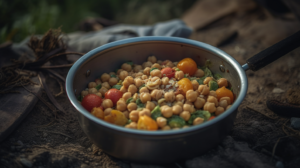 Ingredients:
Ingredients:
- 1 can (15 ounces) of chickpeas
- 1 cucumber
- 1 cup of cherry tomatoes
- 1/2 cup of feta cheese
- 2 tablespoons of olive oil
- Juice of 1 lemon
Instructions:
- Start by draining and rinsing the chickpeas under cold water.
- Peel the cucumber and chop it into bite-sized pieces.
- Halve the cherry tomatoes.
- In a large bowl, combine the chickpeas, chopped cucumber, halved cherry tomatoes, and crumbled feta cheese.
- In a small bowl, whisk together the olive oil and lemon juice to make a dressing.
- Pour the dressing over the salad and toss gently to combine. Serve immediately or store in a cool place until you’re ready to eat.
Life on Wheels: Managing Healthcare and Insurance While on the Road
Hello fellow travellers! If you’re here, you probably already know that life on wheels — be it in an RV or campervan — is a unique blend of freedom, adventure, and yes, some challenges. One of those challenges? Managing healthcare and insurance on the road. It’s a crucial topic that can’t be overlooked, so let’s dive right in.
Understanding Health and Travel Insurance for RV and Campervan Travellers
Travel health insurance isn’t just an optional add-on; it’s an absolute must-have for us road travellers. But navigating the world of insurance can be like traversing a tricky mountain pass.
Different types of insurance policies cater to different travel needs. For instance, some policies might focus on emergency services, while others may offer extensive coverage for medication needs. That’s why it’s important to know what you’re looking at when choosing a travel and health insurance policy.
The key factors? Look for policies that cover a broad range of scenarios, especially those relevant to RV and campervan travel. Things like accident coverage, emergency evacuation, and even return of your vehicle are great to have.
Accessing Healthcare Services on the Road
Just because we’re constantly moving doesn’t mean we can leave our health behind. Accessing healthcare services while travelling can be tricky, but with a little planning and awareness, it’s entirely doable.
Whether it’s an unexpected flu or a sprained ankle from a strenuous hike, knowing where to find emergency services and urgent care can be a game changer. Remember, your GPS is your friend. Use it to locate nearby hospitals, clinics, and pharmacies.
Managing Routine Health and Medication Needs While Travelling
Keeping up with routine health check-ups and managing prescription medications on the road isn’t always easy, but it’s necessary. Try setting reminders for medication or arranging your itinerary so you’re near a healthcare provider when check-ups are due. Also, a well-stocked first-aid kit is an RV or campervan must-have!
A big part of managing routine health is also about maintaining a healthy lifestyle. Remember to balance those road-trip snacks with fresh fruits and veggies, get plenty of exercise, and make time for relaxation, too!
How to Handle Health Insurance Claims on the Road
Health emergencies can be scary, especially when you’re away from home. But knowing how to handle your health insurance claims on the road can bring immense peace of mind.
If you find yourself facing a medical emergency, contact your insurance provider as soon as possible. Keep all bills and documentation; you’ll need them when filing your claim. When dealing with foreign medical bills, it’s important to ask for an English translation to avoid any confusion.
Digital Health Services and Telehealth: A Traveller’s Best Friend
 In this digital age, healthcare has thankfully gone online. Digital health services and telemedicine can be an absolute boon for us road wanderers.
In this digital age, healthcare has thankfully gone online. Digital health services and telemedicine can be an absolute boon for us road wanderers.
Telemedicine lets you consult with healthcare professionals virtually, making it possible to receive medical advice, have prescriptions filled, and even get therapy sessions — all from the comfort of your RV or campervan. I’ve heard from many fellow travellers who have found telehealth services to be a lifeline while on the road.
Preventative Health: Vaccinations and Regular Check-ups
Preventive healthcare is just as important on the road as it is back home. Getting recommended vaccinations before you travel can save you from a lot of health complications down the line.
Also, don’t skip those regular check-ups, even if you’re feeling fine. Remember, it’s easier to prevent health problems than to treat them!
Staying Active on the Road
An important aspect of managing healthcare while on the road is staying active. It can be easy to get caught up in the adventure and overlook the importance of regular exercise, but remember, a healthy body means a healthy mind. Here are a few ways you can incorporate physical activity into your travels:
- Hiking and nature walks: One of the biggest perks of travelling by RV or campervan is the opportunity to explore stunning natural landscapes. Take advantage of nearby trails for a morning jog or an afternoon hike. Not only is this a great way to stay fit, it’s also a chance to appreciate the beauty around you.
- Campsite exercises: There’s no need for a fancy gym when you have the great outdoors. Simple bodyweight exercises such as push-ups, sit-ups, or yoga can be done anywhere, anytime.
- Swimming: If you’re near a beach or a lake, swimming is an excellent way to get a full-body workout.
- Biking: Consider bringing along a bicycle. It’s a fun way to explore and also a fantastic form of exercise.
Mental Health and Wellness
Mental health is just as important as physical health, especially when you’re on the road. The excitement of travel can sometimes be coupled with feelings of homesickness or loneliness. Here are some strategies to help maintain your mental wellbeing:
- Stay connected: Technology makes it easy to keep in touch with friends and family. Regular phone calls, video chats, or even social media updates can help mitigate feelings of homesickness.
- Meditation and mindfulness: These practices can help reduce anxiety and improve your mood. There are plenty of apps available that offer guided sessions, perfect for beginners.
- Maintain a routine: While part of the allure of road life is the lack of a strict schedule, maintaining some sort of routine can provide a sense of normalcy and stability.
- Journaling: Keeping a travel journal can be therapeutic. It allows you to express your thoughts and feelings, document your experiences, and reflect on your journey. For a selection of various types of journals check out my journals available at www.magicalwonderspublisher.com.
Remember, there’s no right or wrong way to travel. It’s about finding a balance that works for you, keeping both your body and mind healthy as you navigate the open road.
Conclusion
Managing healthcare and insurance while on the road isn’t always easy, but with the right knowledge and preparation, it’s definitely manageable. From understanding and choosing the right insurance policy, accessing healthcare services, to managing routine health and medication needs – it’s all part of the journey.
And remember, health technologies like digital health services and telemedicine are your allies. They’ve revolutionized the way we can receive healthcare while traveling, making it easier than ever to stay healthy on the road.
Call to Action
Now, it’s your turn! Have you had experiences managing healthcare and insurance on the road? Have any tips or stories to share? We’d love to hear from you in the comments below. If you found this article helpful, feel free to share it with your fellow travellers. And don’t forget to subscribe for more content!
Frequently Asked Questions
Q: Can I use my regular health insurance while travelling?
Most regular health insurance policies provide limited coverage outside your home area, especially for international travel. It’s best to check with your insurance provider to understand the extent of your coverage.
Q: What should I include in my travel first-aid kit?
Your first-aid kit should include basics like band-aids, antiseptic wipes, tweezers, medical tape, and gauze pads. It’s also good to have any personal medications, pain relievers, allergy medicines, and any other essentials like bug spray and sunscreen.
Q: How does telemedicine work?
Telemedicine involves the remote delivery of healthcare services using technology. It allows you to consult with healthcare professionals over video call, receive medical advice, get prescriptions, and more without visiting a physical location.
Q: How can I keep track of my vaccinations?
Keep a record of your vaccinations and consider using apps or digital health records to store this information. Always check with your healthcare provider or a travel health clinic for the most up-to-date travel vaccination recommendations.
Remember, life on the road doesn’t mean neglecting your health. Happy and healthy travels to all!
Portable Barbecue Alcohol Oven Stove Review
Compact, Versatile, and Environmentally Friendly
Purpose and Key Features
As a long-time enthusiast of all things outdoors, I’m always on the lookout for gear that makes my adventures more enjoyable and hassle-free. That’s how I discovered the Portable Barbecue Alcohol Oven Stove, a sturdy, compact, and versatile cooking solution designed for outdoor enthusiasts.
One of the things that caught my attention was the stove’s use of alcohol as fuel. This makes it not only environmentally friendly, with no chemical emissions and no carbon footprint but also convenient for trips where other fuel sources might be hard to come by.
Product Design and Quality
This compact stove is made from a mix of iron and wood, boasting both anti-corrosion and robust properties. The fire-resistant and high-temperature-resistant material ensures it can withstand the rigors of outdoor cooking. The hollow design effectively filters dust and aids in adjusting the internal air content, thus controlling the heat.
In-depth Analysis: Key Features and Functionality
This portable barbecue alcohol oven stove stands out for its convenient features:
- Portable: Its compact size and the inclusion of a wooden shelf make it easy to pack and carry around.
- Versatile: It’s suitable for a wide range of cooking pots, including soup pots, baking trays, and kettles. You can boil tea, heat a dry pot, and even cook a delicious meal.
- Environmentally friendly: By using alcohol as fuel, it doesn’t contribute to harmful emissions or leave a carbon footprint.
- Additional Grill: The camping stove comes with a grill, which means you can barbecue anywhere you set up your camp.
Comparison with Similar Products
When compared with similar products, the Portable Barbecue Alcohol Oven Stove stands out for its versatility, compactness, and eco-friendliness. Many other stoves on the market lack one or more of these features, making this one a standout choice for outdoor cooking enthusiasts.
Pros and Cons
Pros:
- Lightweight and portable
- Environmentally friendly
- Versatile applications
- Sturdy and durable
Cons:
- As per some user reviews, the wooden base could potentially catch on fire if not handled properly.
User Experiences
Taking a look at online reviews, user experiences with the Portable Barbecue Alcohol Oven Stove are mixed. Many users appreciate its compact and versatile design. However, a few users mentioned issues with the wood base, suggesting it could catch fire if not used cautiously.
Tips and Tricks
To maximize your experience with the stove:
- Always supervise the stove when in use and make sure it’s on a non-flammable surface.
- Practice setting up and lighting the stove before heading out to familiarize yourself with its operation.
FAQs
- What kind of fuel does this stove use?
- This stove uses alcohol as fuel, either in solid alcohol block form or as a pasty fluid alcohol.
- Is it suitable for all types of pots and pans?
- Yes, it can be used with a variety of pots and pans, including soup pots, baking trays, and kettles.
Conclusion
In conclusion, the Portable Barbecue Alcohol Oven Stove is a versatile, compact, and environmentally friendly solution for outdoor cooking. While care should be taken with the wooden base, its convenience and adaptability make it a solid choice for campers, hikers, and outdoor adventurers who want a reliable cooking option on the go. To check out the Portable Barbecue Alcohol Oven on Amazon click here, to check out a fuel source for it, click here.
Fancy Heat Eco-Friendly Green Ethanol Chafing Dish Fuel Review
Purpose and Key Features
As someone who often finds themselves needing a reliable heat source for various reasons, I found Fancy Heat’s Eco-Friendly Green Ethanol Chafing Dish Fuel to be quite the game-changer. Whether you’re planning an outdoor camping trip, preparing for potential power outages, or even just making tabletop S’mores, this versatile product has you covered.
The Fancy Heat fuel promises to burn very hot for an impressive 2.5 hours per can. The best part? It’s eco-friendly, which aligns perfectly with my goal to make more environmentally conscious choices.
Product Design and Quality
Each canister of Fancy Heat chafing dish fuel is quite compact and lightweight (weighing just 0.2 kilograms), making it super easy to store or carry around. It’s a liquid fuel that’s been designed to burn very hot, yet it’s safe to use both indoors and outdoors.
In-depth Analysis: Key Features and Functionality
One of the things I absolutely adore about the Fancy Heat chafing fuel is how versatile it is. Whether you need to boil a pot of water on an emergency stove, light coals for a barbecue, or roast marshmallows indoors, this fuel is up to the task.
While it can reach high temperatures, it does so without filling the indoors with toxic fumes – a major plus for those unexpected winter power outages when you’re stuck cooking inside.
Comparison with Similar Products
Compared to other similar fuels on the market, the Fancy Heat ethanol fuel stands out for a few key reasons. Its eco-friendly nature is a significant advantage, and the fact it can burn for a considerable 2.5 hours makes it a dependable choice.
Pros and Cons
Pros:
- Burns very hot
- Lasts for 2.5 hours
- Eco-friendly
- Versatile for various uses
Cons:
- As one user noted, it’s not as fast as an alcohol burner
User Experiences
Reviewing the online testimonials, it seems many users share my positive view of the Fancy Heat chafing dish fuel. Several users mention using it for cooking during power outages, while others noted it’s great for outdoor camping trips. Users praised its safety, ease of use, and the fact that each can be resealed for multiple uses.
Tips and Tricks
To get the most out of the Fancy Heat chafing fuel, here are a couple of tips:
- Ensure you have a safe, non-flammable surface to place the can on while burning.
- Reseal the can carefully after each use if you plan to use it multiple times.
FAQ Section
- Can this get a pot of water to boil on an emergency stove?
- Yes, it can.
- Can this be used for Lighting coals?
- It’s meant for indoor use only.
- Can these be used indoors to roast marshmallows?
- Yes, they can.
- Would this work for an oil fondue?
- It’s not recommended since the oil for fondue needs to get past 300 degrees F or 149 degrees Celsius.
Conclusion
All in all, the Fancy Heat Eco-Friendly Green Ethanol Chafing Dish Fuel offers a versatile and reliable heating solution. Whether you’re an avid camper or just someone who wants to be prepared for unexpected circumstances, this is a product worth considering. Especially if you are in a campervan and just want a small “fire” for s’mores or just toasted marshmallows and do not want to make a big fire. This fuel works well with this compact alcohol reviewed here. Its eco-friendly nature, efficient burning time, and versatility make it a superior choice. While it might not heat up as quickly as an alcohol burner, the safety and environmental benefits more than make up for that.
It’s also important to remember the value of user experiences. Users have reported success in a range of situations, from emergency heat during power outages to safe indoor s’mores-making. That said, the Fancy Heat fuel canisters might not be your best bet for something like oil fondue, which requires higher temperatures.
If you’re on the lookout for a reliable, eco-friendly, and long-burning heat source, the Fancy Heat Eco-Friendly Green Ethanol Chafing Dish Fuel is worth a shot. But, as always, be sure to use it responsibly and with the appropriate safety precautions.
In conclusion, I would highly recommend this product to anyone in need of a versatile heat source, whether for indoor or outdoor cooking, emergencies, or just a fun, safe way to make s’mores at home. Its environmental friendliness is just the icing on the cake! Check it out here.
Granola and Yogurt Parfait
 Ingredients:
Ingredients:
- 2 cups of your favorite granola
- 2 cups Greek yogurt
- 1 cup fresh berries (strawberries, blueberries, raspberries, etc.)
Instructions:
- Grab two cups or glasses. Layer 1/4 cup of granola at the bottom of each cup.
- Add 1/4 cup of Greek yogurt on top of the granola in each cup.
- Layer 1/8 cup of fresh berries on top of the yogurt.
- Repeat these layers until the cups are filled, finishing with a layer of berries on top.
- Serve immediately, or refrigerate for up to 2 hours before serving.
FireHiking Titanium Stove: An Honest Review
 Camping, backpacking, or hunting, the need for a reliable, compact, and lightweight stove is a crucial part of our gear list. That’s where the FireHiking Titanium Stove comes into play. With its unique features like portability, rust and corrosion-resistant titanium construction, and foldable design, it becomes an attractive choice for outdoor enthusiasts. But how does it hold up in practice? Let’s dive into a comprehensive review of this product.
Camping, backpacking, or hunting, the need for a reliable, compact, and lightweight stove is a crucial part of our gear list. That’s where the FireHiking Titanium Stove comes into play. With its unique features like portability, rust and corrosion-resistant titanium construction, and foldable design, it becomes an attractive choice for outdoor enthusiasts. But how does it hold up in practice? Let’s dive into a comprehensive review of this product.
Design and Quality
With its emphasis on portability, the FireHiking Titanium Stove features a foldable design that reduces its size considerably, making it an ideal choice for backpacking. This compact stove, weighing only 3.4lb, can easily be stowed away in your backpack.
The quality of the material is another strong suit of this stove. Constructed with titanium, this stove boasts high strength, excellent heat resistance, and immunity to rust and corrosion. Additionally, it features a glass window for observing fuel combustion and conveniently adding fuel when needed.
Key Features and Functionality
The FireHiking Titanium Stove truly stands out with its clever design and unique features:
- Portability: With its foldable design, this stove minimizes space usage, which is essential when packing for a trip.
- Durability: Made of titanium, it’s built to withstand harsh conditions and high temperatures.
- User-friendly Design: The transparent glass window lets you keep an eye on the fuel combustion and helps you gauge when you need to refuel.
Comparison with Similar Products
Compared to other portable stoves on the market, the FireHiking Titanium Stove comes out on top with its unique blend of portability, functionality, and durability. While other stoves might be lighter or smaller, they often compromise on durability or ease of use, something this stove seems to balance exceptionally well.
Pros and Cons
Pros:
- Compact and portable
- Durable and heat-resistant titanium construction
- User-friendly design with a transparent window
Cons:
- The stove pipe might be a bit tricky to roll out
- No connectors or rope provided for guying out the spark arrestor
User Experiences
The FireHiking Titanium Stove has received overwhelmingly positive reviews from users. Most customers appreciated its heat output, stating it warms up their tents effectively. Some users have expressed minor concerns about the stove pipe and the spark arrestor, but these do not overshadow the product’s overall positive feedback.
Tips and Tricks
For optimal usage of your FireHiking Titanium Stove, consider the following tips:
- Use a piece of pipe to roll out the stove pipe before usage. It helps the pipe to look less crinkly.
- For guying out the chimney, you can use key loops or metal cable attached to the top ring below the cap.
FAQs
- What side is the window on?
- The window panels are interchangeable. You can set up the glass on either the right or left side.
- In what country is the stove made?
- The product is believed to be made in Thailand, as per the information on the packaging.
Conclusion
In conclusion, the FireHiking Titanium Stove stands as a fantastic choice for those seeking a portable, durable, and efficient stove for their outdoor adventures. Despite a few minor hiccups, the stove’s performance, design, and user-friendly features make it a product worthy of consideration for your next trip. Whether you’re an occasional camper or an experienced backpacker, this stove is likely to cater to your needs effectively. Click here to check the stove out on Amazon.
The Art of Cooking on the Road: RV and Van Life Recipes
Hello fellow travelers! Cooking on the road can be a fun and creative challenge. Between the minimal storage space, limited resources, and unpredictable conditions, it may seem daunting at first. But fear not, with a little planning and some clever recipes, you can whip up delicious, nutritious meals in no time. In this article, I’ll share with you my favorite van life recipes for breakfast, lunch, and dinner.
Understanding Your Cooking Space
Before we jump into the recipes, it’s important to understand your cooking space. Most vans and RVs are equipped with a basic cooking facility, like a gas stove or electric burner. Some might even have a microwave or an oven. Space is usually at a premium, so organization and efficiency are key. Prioritize versatile cookware and utensils, and learn to love one-pot meals – they’ll be your best friend!
Planning and Preparing Meals
One of the best tips for van life cooking is to plan your meals in advance. This doesn’t mean you can’t be spontaneous, but knowing roughly what you’ll be eating for the next few days will make grocery shopping and food storage much easier. Consider preparing some meals in advance and utilizing leftovers to maximize your food and minimize waste.
Simple, Nutritious Recipes for the Road
Let’s dive into some delicious, easy-to-make recipes perfect for van life. Whether you’re a fan of hearty breakfasts, light lunches, or satisfying dinners, I’ve got you covered. These recipes have minimal ingredients, require little preparation, and are designed to be cooked with limited resources. Plus, they’re healthy and packed with the nutrients you’ll need for your adventurous lifestyle.
Breakfast Recipes
Start your day off right with these filling and nutritious breakfast options:
- Overnight Oats: This is a no-cook, prepare-ahead recipe that’s perfect for early mornings. Just mix the oats, milk, Greek yogurt, and honey in a jar, top with your favorite fruits and nuts, and let it sit in the fridge overnight.
- Campfire Breakfast Burritos: Cook scrambled eggs and sausage or bacon on your stove or campfire, wrap it up in a warm tortilla, and voila – a handheld breakfast that’s perfect for on-the-go.
- Banana Pancakes: These 3-ingredient pancakes are both simple and satisfying. All you need are bananas, eggs, and a bit of flour. Plus, they can be customized with add-ons like chocolate chips or blueberries.
For the complete breakfast recipes and more, click here.
Lunch Recipes
When it comes to lunch on the road, we want something quick, easy, and light. Here are a few options:
- Chicken and Veggie Foil Packets: This recipe is simple, nutritious, and requires minimal cleanup. Just place your chicken and veggies on a foil, season, and let it cook on the campfire or stove.
- Tuna Salad Wraps: A classic, easy lunch option. Mix canned tuna with mayonnaise and celery, spread it on a tortilla, add some lettuce, and roll it up.
- Caprese Skewers: An Italian classic turned road-friendly. Just thread a cherry tomato, a mozzarella ball, and a fresh basil leaf onto a skewer. Drizzle with olive oil and balsamic glaze before serving.
For the complete recipes and more, click here.
Dinner Recipes
After a long day of adventure, you’ll want a comforting and filling meal. Here are some dinner recipes you can try:
- One-Pot Pasta: Minimal cleanup and maximal flavor, this recipe is a van life staple. You only need pasta, tomato sauce, garlic, olive oil, and your preferred Italian seasoning. Sauté the garlic, add pasta, sauce, and water, then let it cook until the pasta is tender.
- Campfire Chili: Hearty and warming, this chili is perfect for cooler nights. Cook your choice of ground meat with onions and garlic, add beans, tomatoes, and spices, then let it simmer until heated through.
- Fish Tacos: This simple and fresh recipe requires flaked grilled fish, coleslaw mix, tartar sauce, and tortillas. Pile everything on a tortilla and enjoy.
For the complete recipes and more, click here.
Snack Recipes for the Road
Every road tripper knows the importance of a good snack stash. It keeps the hunger at bay and fuels your adventures. Here, let’s dive into some simple and tasty snack recipes that you can prepare in your van or RV.
Firstly, let’s talk about the all-time favorite, Trail Mix. This one is super customizable. Combine your favorite nuts, seeds, dried fruit, and a bit of something sweet like dark chocolate chunks. You could even toss in some coconut flakes or popcorn. Just mix it all together, and you’ve got yourself a protein-packed snack that’s ready to go.
Fresh fruit is another fantastic road trip snack. It’s as easy as washing and packing a bunch of apples, bananas, or oranges. You could even kick things up a notch and create a fresh fruit salad. Just chop up your favorite fruits and mix them in a container. Add a squeeze of lemon juice to keep the fruit from browning, and you’re set.
Cheese and Crackers is a classic that never gets old. Grab some whole grain crackers and pair them with pre-sliced cheese. Experiment with different types of cheese, like cheddar, gouda, or even brie. For a little extra flavor, add a slice of cured meat or a dollop of jam.
Hummus and Veggies is a snack that’s as nutritious as it is delicious. Just cut up some bell peppers, cucumbers, and cherry tomatoes, then dip them in your favorite hummus. You could even make your own hummus by blending canned chickpeas, olive oil, tahini, lemon juice, and garlic.
Yogurt and Granola is a lovely combination of creamy and crunchy. Fill a jar with your favorite yogurt, then add a layer of granola on top. You could even add some fresh fruit or a drizzle of honey for a touch of sweetness.
Jerky is a snack that packs a protein punch. If you’re feeling adventurous, you could make your own by marinating lean meat in your favorite flavors and drying it in a low oven or dehydrator. Alternatively, look for brands with low sugar and sodium content.
Last but certainly not least, is Popcorn. You could pop a bag before you hit the road or, if you have a stove in your van or RV, make it fresh whenever you want. Just heat some popcorn kernels in a bit of oil, put a lid on it, and wait for the magic to happen. For added flavor, toss the popcorn in a mix of spices, like chili powder and nutritional yeast.
Each of these recipes can be prepared ahead of your journey, so you’ll always have tasty snacks at hand. With these in your snack arsenal, you’ll be ready for the road in no time! Enjoy the van life, full and satisfied!
Check out the snack recipes here.
Cooking with Limited Resources
When you’re living the van life, you often have limited resources, like water and power. This means it’s important to find ways to cook efficiently. One-pot meals, like the one-pot pasta or campfire chili mentioned above, are a great way to minimize cleanup. Also, consider no-cook options, like the overnight oats or tuna salad wraps.
Food Storage and Preservation
Proper food storage is crucial when you’re on the road. For refrigerated items, a cooler or a small fridge can work wonders. For non-refrigerated items, ensure they’re stored in a cool, dry place. And remember, many fresh ingredients, like fruits, vegetables, and certain dairy products, can last a few days without refrigeration if they’re stored properly.
Dining Out vs. Cooking In
While it can be tempting to eat out all the time, cooking in your van or RV can save you money and is often healthier. But don’t deny yourself the pleasure of trying local cuisine! Striking a balance between dining out and cooking in can enrich your travel experience while keeping you on a budget.
Kitchen Tools and Gadgets
While it’s important to keep things minimal when you’re living on the road, there are certain kitchen tools and gadgets that can make your life much easier. Here’s a shortlist:
- Portable Stove or Cooker: A portable stove will provide you with a reliable heat source for cooking.
- Cooler or Mini Fridge: For keeping perishable food items fresh.
- Multi-purpose Utensils: Look for utensils that can perform multiple tasks to save space and simplify cooking.
- Compact Cutting Board: A small, durable cutting board is a must-have for food preparation.
- Collapsible Containers: They’re great for storing food or leftovers and they take up less space when not in use.
Conclusion
Cooking on the road doesn’t have to be a chore. In fact, it can be a fun and rewarding part of your van life experience. With a bit of planning and the right recipes, you’ll be whipping up delicious meals wherever your travels take you.
I encourage you to share your own on-the-road recipes and cooking tips. Your input can provide other readers with new ideas and help build our community of road warriors!
FAQ
Q: How do I store food without refrigeration? A: Choose foods that have a longer shelf life, like canned goods, rice, pasta, and certain fruits and vegetables. Store them in a cool, dry place.
Q: Can I cook over an open fire? A: Absolutely! Just make sure it’s permitted and safe in your current location. Always practice fire safety.
Q: What’s the best way to clean dishes on the road? A: Use biodegradable soap and a small basin to wash dishes. Always dispose of your water well away from natural water sources.
Call to Action
Lastly, if you found this article useful, feel free to share it with other van life enthusiasts. Let’s spread the love for food and adventure!
Bon appétit and happy travels!
This article was written with the hope to guide you through your culinary journey during your van life experience. The recipes are simple, nutritious, and perfect for a life on the road. The dishes range from hearty breakfast burritos to comforting one-pot pasta and are sure to please. With the right recipes, cooking on the road becomes an adventure in itself!
